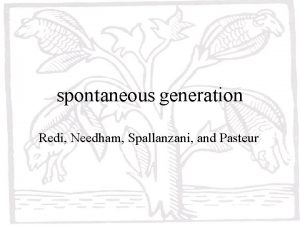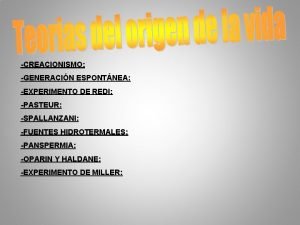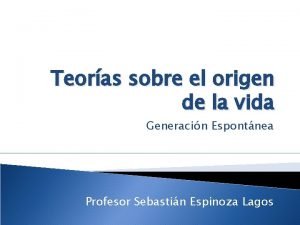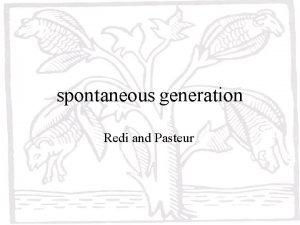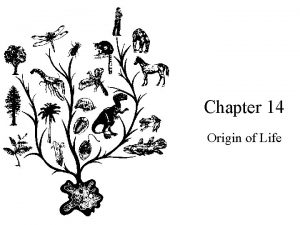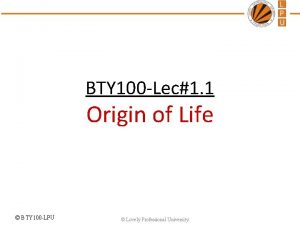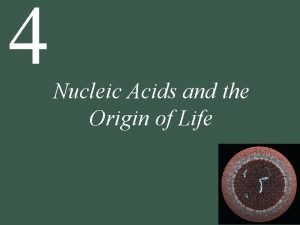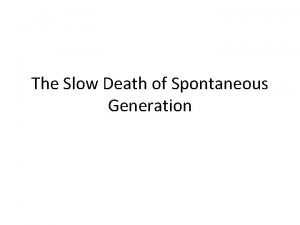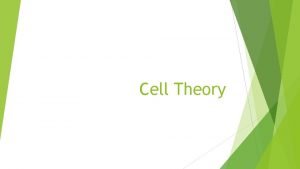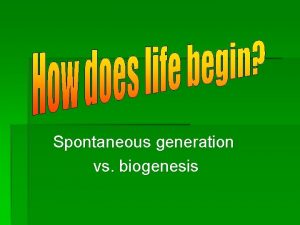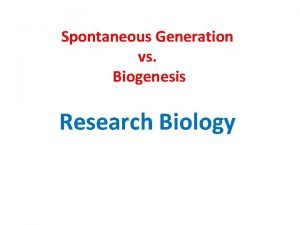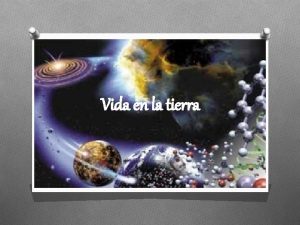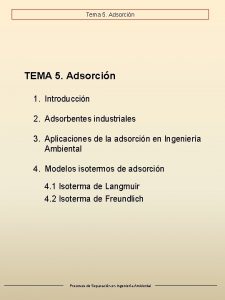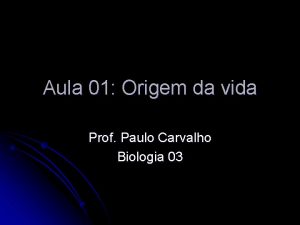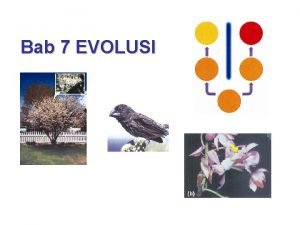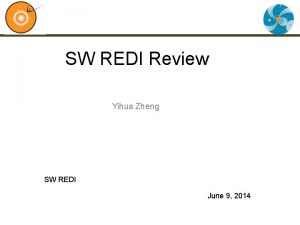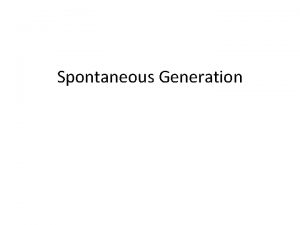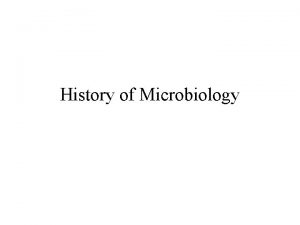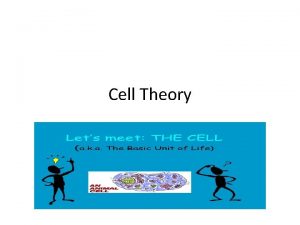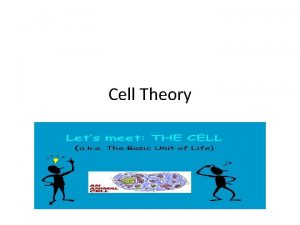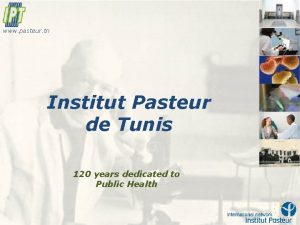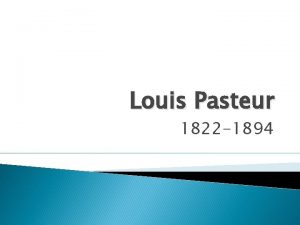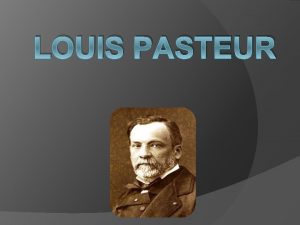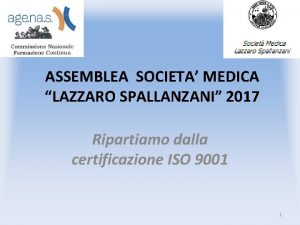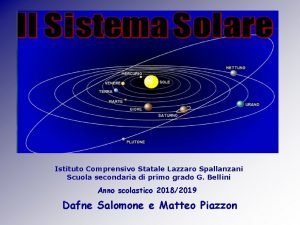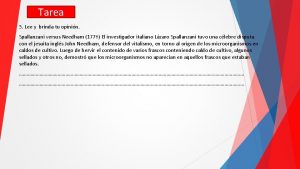spontaneous generation Redi Needham Spallanzani and Pasteur Spontaneous






















- Slides: 22

spontaneous generation Redi, Needham, Spallanzani, and Pasteur

Spontaneous Generation • For much of history, people believed that animals could come from non-living sources. They thought: – Frogs developed from falling drops of rain – mice arose from sweaty underwear – and flies arose from decaying meat. • This is called abiogenesis • Also known as spontaneous generation

• These ideas were followed because people simply accepted what they were told

The Power of Authority • In the past, people believed what they were told by “authorities” such as the Church, or the ancient Greek philosopher Aristotle • Questioning Aristotle was like questioning the Church. .




• One “scientist” put forward the belief that mice could be generated spontaneously from wheat and a sweaty shirt. • The wheat provided the “nutritive power” and the shirt provided the “active principle. ” • “active principle” = a mysterious “life-force” that allowed spontaneous generation to occur.

1668 -- Francisco Redi (Italian physician & poet)-attempted to disprove theory of Spontaneous Generation.

“The flesh of dead animals cannot engender worms unless the eggs of the living being deposited therein” • Put dead snakes, eels, and veal in large wide mouthed vessels. Sealed one set with wax and left the other set open to air. • Decaying meat was teeming with maggots, sealed meat had no maggots • Wax sealed vessels failed to produce maggots because flies were unable to reach the meat

Redi’s critics said: • You have too many variables • There is a lack of access and a lack of air. • We ALL know that everything needs air • Of course no flies grew! • You haven’t proven anything.

Redi part 2 – answer to critics fine mesh allows in air, but not flies laid eggs on top of mesh no maggots in meat

Redi’s Conclusions: • “All living beings come from seeds of the plants or animals themselves” • However, if someone were to demonstrate even one exception to this hypothesis, then Redi’s hypothesis would be rejected.

John Needham (English Clergyman) wondered if this would work with micro organisms in 1745 • Everyone knew that boiling killed organisms. • Needham prepared various broths and showed that they contained microbes. • Then he boiled them, and showed that there were no longer any microbes. • He ensured the stoppers were loose, so that air would not be excluded • Then, after a few days, microbes had reappeared! • This was “proof” that the microbes had spontaneously generated from the non-living broth.

Needham’s error • BUT: how was this evidence of a faulty experiment? – what ERROR in experimental method is shown here? • Hypothesis: microbes MUST HAVE arisen spontaneously from the broth. • Assumption: there is no other place the microbes could come from (other than the broth). • error: microbes could have come from the air!

Spallanzani’s (Italian Naturalist) -- 1745 • • Disagreed with Needham Claimed he didn’t seal jars well enough He said microbes could have come from the air He repeated Needham’s experiment, but changed two things: – boiled flasks longer, and – SEALED THEM after boiling by fusing the glass tops shut – (hermetically sealed – absolutely airtight) • Result: NO growth in ANY flask

Needham criticizes Spallanzani’s first experiment • BUT Needham said: you boiled it TOO LONG, and: • You spoiled the vegetative power by boiling. • You killed the ability of the broth to give life. • Life can still come from broth -but the broth must not be “damaged” by boiling.

Spallanzani’s second experiment tight seal • he did TIMED BOILINGS • then left them partially sealed • some partially sealed, some hermetically sealed as in his previous experiment • hypothesized that more boiling should lead to less life • he left some jars as Needham had (leaky seals), to ensure “active principle” was not damaged 30 mins 60 mins 90 mins 120 mins loose seal

Spallanzani’s second experiment -- results tight seal • this showed TWO main things: • boiling did NOT damage broth’s ability to support life • growth depended on the SEAL only 30 mins 60 mins 90 mins 120 mins loose seal

Louis Pasteur 1859– (French chemist) entered a contest sponsored by French Academy of Sciences to prove or disprove Spontaneous generation. • used swan-necked flask • flask allowed in air, but trapped dust (and microbes) • boiled infusion • showed that NO growth occurred, even after many days • BUT -- what about damaging the “active principle”?

• Pasteur showed that the active principle was NOT damaged • at any later time, he could tip the flask • this allowed nutrient broth to contact the dust • this carried microbes into the broth • result: growth! area where dust had been trapped

Pasteur squashes the idea of abiogenesis completely! • Since then, no one has been able to refute Pasteur’s experiment • scientists everywhere soon came to accept that abiogenesis did NOT EXIST. • but: then how did life on this planet start in the first place?
 Lazzaro spallanzani experimento biogenesis
Lazzaro spallanzani experimento biogenesis Experimento de creacionismo
Experimento de creacionismo Needham experimento
Needham experimento What did spallanzani do to improve upon redi's
What did spallanzani do to improve upon redi's Rediand
Rediand Louis lerman experiment conclusion
Louis lerman experiment conclusion Disproving spontaneous generation
Disproving spontaneous generation Disproving spontaneous generation
Disproving spontaneous generation The slow death of spontaneous generation
The slow death of spontaneous generation Spontaneous generation in data flow diagram
Spontaneous generation in data flow diagram Whats spontaneous generation
Whats spontaneous generation Four model approach
Four model approach Whats spontaneous generation
Whats spontaneous generation Spontaneous generation vs biogenesis
Spontaneous generation vs biogenesis Biogenesis pros and cons
Biogenesis pros and cons Second generation vs first generation antipsychotics
Second generation vs first generation antipsychotics Lord your mercy endureth forever
Lord your mercy endureth forever Needham roberts
Needham roberts Needham experimento
Needham experimento Teoria needham
Teoria needham Abiogenistas
Abiogenistas Teori asal usul kehidupan disusun berdasarkan ....
Teori asal usul kehidupan disusun berdasarkan .... Evolusi weismann
Evolusi weismann
